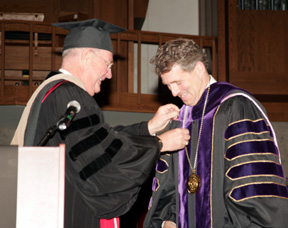 |
University of Nebraska Regent Howard Hawks installs James B. Milliken as the sixth president of the University of Nebraska. Photos by Tim Fitzgerald. |
The ceremony was one of a number of activities that began Wednesday in Scottsbluff and Kearney, and continued Thursday in Omaha and Lincoln to celebrate the installation of the president and to recognize the important role of the University of Nebraska throughout the state.
In his installation address Milliken lauded Nebraska’s earliest pioneers who, in 1869, just two years after Nebraska became a state, chartered the university. He said education is even more important today than it was 100 years ago.
“We know, for example, that the average lifetime earnings of a Nebraskan with a bachelor’s degree are a million dollars more than those of a person with only a high school diploma,” Milliken said. “But a university education provides for more than the means for an individual to earn a living — important as that is. As we look around the world, we are reminded that an enlightened democracy depends on an educated citizenry.”
Milliken said education also has the power to transform a state, and noted that Nebraska is faced with serious economic challenges, demographic shifts, and a structural fiscal dilemma in state government.
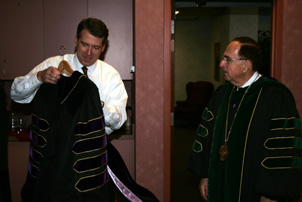 |
James B. Milliken, left, prepares for his installation ceremony as UNMC Chancellor Harold M. Maurer, M.D., looks on. |
Milliken said leading economic research highlights universities as important hubs of creative activity that spur technology and innovation-based development. He pointed to the University of Nebraska’s Peter Kiewit Institute, J.D. Edwards program, and Durham Research Center as excellent models to build upon. “We need to set our sights high, take advantage of our strengths, and vigorously pursue a better quality of life for Nebraskans,” Milliken said.
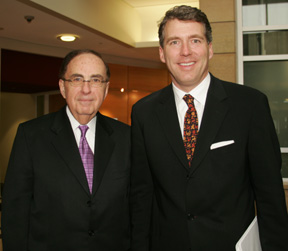 |
James B. Milliken with UNMC Chancellor Harold M. Maurer, M.D. |
Among the barriers to college attendance that Milliken cited is a lack of affordable access. “Economic circumstance should not prevent any Nebraskan from attaining a college education,” he said. Milliken said providing an adequate level of need-based aid and keeping tuition at a reasonable level will help ensure that smart, capable students can attend the university. He said affordable public education requires adequate state investment since the primary sources of funds for the university are state appropriations and tuition dollars. And he said that increasing the diversity in higher education is one of the keys to a prosperous Nebraska.
Milliken, who was raised in Fremont and earned his bachelor’s degree with distinction in English from UNL in 1979, making him the first Nebraska-born NU president, said he has been impressed upon his return to Nebraska to find faculty who are passionate about their work and who are making a tremendous contribution to Nebraska. “The principal difference between mediocrity and excellence in higher education is the faculty,” he said.
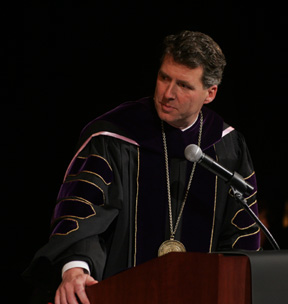 |
James B. Milliken is installed as the sixth president of the University of Nebraska. |
Milliken said a robust research agenda is essential to Nebraska’s success in an economy that depends on knowledge and innovation.
“Public universities have historically led the way in transmitting and applying new knowledge, and we will continue to do so,” Milliken said. “However, today’s innovation-based economy demands new models of engagement between the university and the state, and new ways to share intellectual resources and research with Nebraska citizens and businesses. I will ask Nebraskans to help us determine how and when and where the university can be most helpful and engage most effectively.”
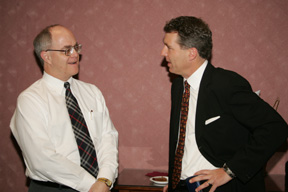 |
James B. Milliken, right, and James Armitage, M.D., talk prior to Thursday’s installation ceremony. |
“The message I heard repeatedly is that the people of Nebraska love this university,” Milliken said. “To many, it is the most significant institution in the state. They recognize that it is not only the key to upward mobility for themselves and their children, but that the university is the key to a Nebraska that is prosperous and offers a good quality of life to its citizens.”
The hour-long ceremony captured Milliken’s pride in his home state, starting with a reading by U.S. Poet Laureate and UNL English professor Ted Kooser, “This is Nebraska,” and continuing through the ceremony and presentation of the medallion of office by NU Board of Regents chair Howard Hawks.
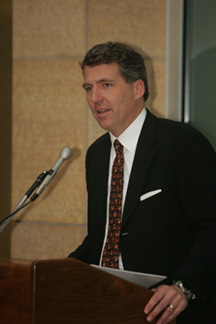 |
Following the installation, James B. Milliken addresses a lunch crowd at the Durham Research Center. |
“The University of Nebraska is possibly the most important single investment our state makes in its future. Your positive and enthusiastic leadership will help all of us optimize that investment.”
In addition to Dr. Armitage and UNMC Chancellor Harold M. Maurer, M.D., the following UNMC faculty were part of the installation: Ellen Davis-Hall, Ph.D., Mary Haven, Don Leuenberger, Rosaline Olade, Ph.D., Rubens Pamies, M.D., Thomas Rosenquist, Ph.D., and Virginia Tilden, D.N.Sc.
The welcome address was given by Molly Corbett Broad, president of The University of North Carolina, where Milliken previously worked as senior vice president for university affairs.
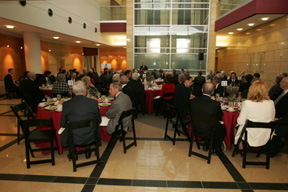 |
The Durham Research Center was the site of a luncheon reception for President Milliken. |
She said Milliken takes the helm of NU “at a time when the responsibilities of leadership have never been greater; when the tasks have never been more challenging, when the obstacles have never been more formidable. But in the same vein, the needs and the opportunities within higher education have never been greater.”